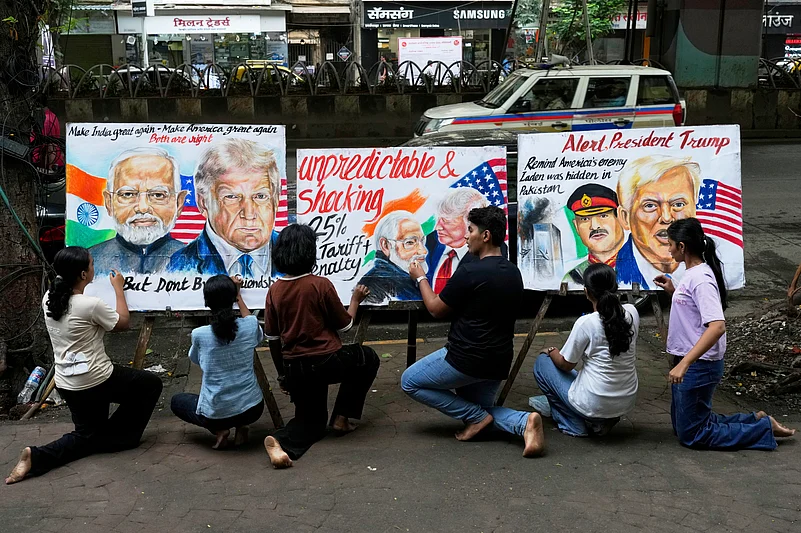
On August 7, the US imposed 25 per cent import duty of goods from India.
Six product groups―mobile phones, pharmaceuticals, petroleum products, iron and steel products, gems and jewellery, and garments―have driven India’s exports to the US
With India’s exports facing unprecedented uncertainties, the government and businesses need to promptly work out a strategy
On August 7, the US imposed 25 per cent import duty of goods from India, implementing President Donald Trump’s decision to impose reciprocal tariff on trade partners. But a day earlier, Trump announced that an additional ad valorem duty of 25 per cent would be levied on Indian imports from August 27, for importing crude oil from the Russian Federation.
By delaying implementation of the additional duty, the Trump signalled his willingness to give India three weeks to stop importing Russian oil. The Government of India’s response was that India was being unfairly penalised as several countries, including China, Türkiye, Brazil, and the European Union (EU), were also buying oil and oil products from the Russian Federation. This meant the impasse between India and the US on the tariffs issue is here to stay, and, therefore, the pertinent question is: how significantly would Trump-tariffs adversely affect India’s exports? This question does not have a straightforward answer.
India’s dependence on US markets consistently increased since the world’s largest economy became India’s largest export destination, replacing the UAE in 2012-13. USA’s share in India’s exports, which was then 12 per cent, increased to 23 per cent during the first five months of 2025. The Trump-tariffs are, thus, expected to have a major impact on Indian businesses not just because several key industries have large exposures to the US market, but also because the growth of India’s exports to the US since the post-pandemic recovery has been almost four times higher than its overall export growth. For a country whose exports have remained sluggish in the recent past, restrictions on access to its largest market would adversely affect India’s trade account and its current account deficit as well.
Six product groups―mobile phones, pharmaceuticals, petroleum products, iron and steel products, gems and jewellery, and garments―have driven India’s exports to the US, accounting for almost one-half of India’s total exports in the first half of 2025. Petroleum products were the third-largest in India’s export basket to the US with over six per cent share, indicating that under the Trump administration, the US was “indirectly importing Russian Federation oil”. This was the precise reason for which the Trump imposed an additional ad valorem duty of 25 per cent on India’s imports. It may also be mentioned here that during January-June 2025, the US accounted for over nine per cent of India’s exports of petroleum products, the highest since Russia’s invasion of Ukraine.
Further, the largest export destination of India’s petroleum product exports, with a 20 per cent share in January-June 2025 (21 percent in 2024), was the Netherlands. But even after “indirectly” importing Russian oil via India, Trump did not impose additional import duty on the EU member states. Thus, Trump’s imposition of the additional import duty on India, reeks of double standards like no other.
With almost 50 per cent of its exports facing the heat of Trump-tariffs, India’s aspirations to expand its footprint in the global economy could be severely dented. However, there is a minor relief as two product groups―mobile phones and pharmaceuticals―are currently exempted from the 25 per cent import duty. But these products are also being investigated under Section 232 of USA’S Trade Expansion Act of 1962. This Section authorises the US President to impose import restrictions, including tariffs, if the Secretary of Commerce determines that a product “is being imported into the US in such quantities or under such circumstances as to threaten to impair the national security”. It may be pointed out that products from the steel industry were subjected to Section 232 investigation earlier and an additional tariff of 50 per cent is already being levied.
Clearly, uncertainty looms large on exports of mobile phones and pharmaceuticals, India’s fastest growing exports over the past few years. Since 2018-19, mobile phone exports increased over five-fold, the US being India’s largest export market. Until 2024, USA’s share in India’s mobile phone exports was around 33 per cent, but in the first half of 2025, this figure rose to over 68 per cent, making phone manufacturers in India extremely vulnerable to Trump-tariffs. The reason behind this steep increase in India’s mobile phone exports to the US was the dramatic reduction in China’s exports. In 2024, China’s share in USA’s imports of mobile phones was 45 per cent, but during January-June 2025, it was down to 23 per cent. On the other hand, India’s share increased from less than six per cent in 2024 to 19 per cent in 2025, largely by capturing the market Chinese producers had vacated in anticipation of the uncertainties unleashed by Trump. This short-sightedness of the Indian mobile phone producers could hit them hard when the US imposes tariffs on mobile phones.
One of the largest suppliers of affordable generic medicines in the world, the Indian pharmaceutical industry has been exporting close to 40 per cent of its total exports to the US. As in the case of mobile phones, Indian exporters have also been increasing their presence in the US market. But what was a prudent strategy in the past, could now become a source of concern with Trump-tariffs looming large. It may be argued that since Indian medicines are popular In the US, especially among the elderly and those without insurance cover, this market could be less affected as very few countries have the ability to supply large quantities of affordable generics. But if higher tariffs are imposed later, this could provide difficult for the Indian players.
The worst fallout of the Trump-tariffs would be on the labour-intensive garments and the gems and jewellery industries. Over the past two decades, India’s garment industry has lost considerable ground in the global markets to Vietnam and Bangladesh, and this trend could continue since both of India’s competitors face lower tariffs as compared to India. On the other hand, the gems and jewellery industry could survive as its products are inelastic in nature, and the Indian diaspora is unlikely to significantly reduce its imports from India.
With India’s exports facing unprecedented uncertainties, the government and businesses need to promptly work out a strategy to reduce their exposure to the US markets, much like the way China has been able to achieve.
(The author is a trade economist and former professor at the Jawaharlal Nehru University and Director General of the Research and Information Systems for Developing Countries)
(Views expressed are personal)























